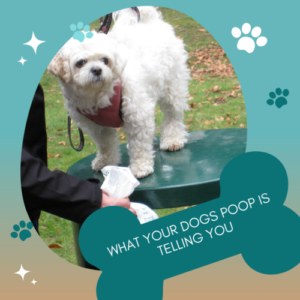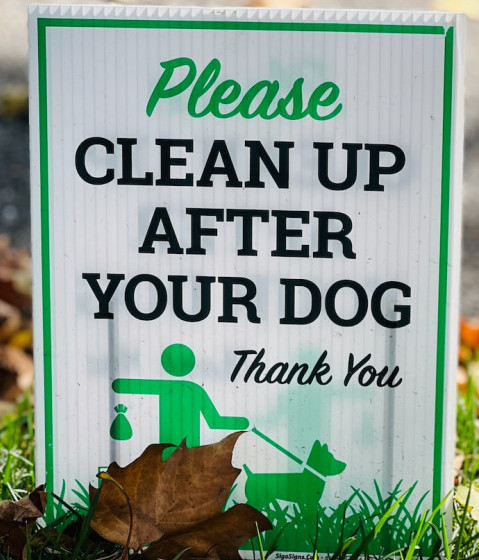
Who wants to walk through a poop “minefield”? Not me and not the neighbors. Cleaning up after your dog is not only good for shoes, it is a good mini check-up for the dog. Our furry friends bring joy and companionship to our lives, but they can’t tell us when something is wrong with their health. It’s up to us to learn what to watch for. One way to gain insight into our dog’s well-being is by paying attention to their poop. While it may not be the most pleasant thought, being aware of our dog’s stool can reveal valuable information about their health. As good neighbors and responsible pet owners, when we clean up after our dogs, we have the perfect opportunity to notice the color, and consistency of our dog’s feces. Understanding how to interpret these attributes allows us to detect potential issues and take early steps to ensure our pet’s well-being.
Normal Dog Poop Color
One of the first things to observe in your dog’s poop is its color. Normal dog poop should be brown, soft, and well-formed. This indicates proper digestion and absorption of nutrients.
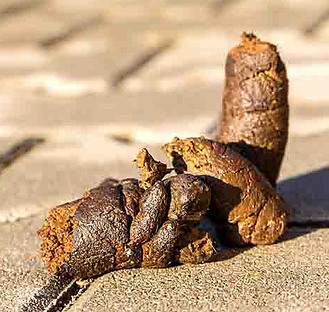
Brown Poop with White Dots Can Mean Parasites
If there are small white dots in the poop, this may mean your pooch has worms or other parasites. You should take a sample to a veterinarian for testing.
Black Poop Means Blood
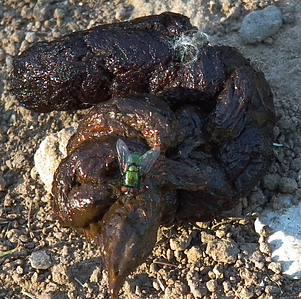
Black dog poop most often comes from digested blood. Eating something black can cause black poop, but more often it comes from bleeding somewhere in the upper digestive system. The red blood turns black as it is digested. Black blood in the stool can come from your dog’s mouth, throat, stomach, or small intestine. It can be caused by ulcers, foreign objects, inflammation from a virus or parasites, cancer, or trauma. Make an appointment with your vet if your dog has more than one black poop.
Red in the Poop is also Blood
Similarly, red poop indicates blood in the digestive tract, but from later in the system, from places like the colon, rectum or anus. In this case, the blood stays red because it does not get digested. If your dog has one poop with a streak of blood, it is probably not something to be concerned about. However, if it continues, you should see your vet to determine the cause.
Orange or Yellow Poop Can Mean Digestive Issues
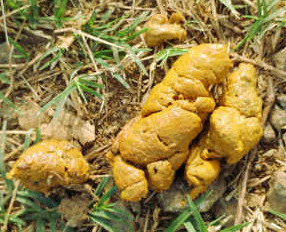
Orange or yellow dog poop is usually not a serious issue when it only happens once or twice in a normal, well-formed stool, and your dog acts healthy and happy otherwise. However, if the unusual color persists, if it becomes diarrhea, or if it is accompanied by other symptoms of gastrointestinal distress, such a vomiting or excessive flatulence, you should visit your vet. The orange color could be caused by eating an excessive amount of orange food, like a pumpkin or carrot. Orange and yellow poop can indicate a relatively minor stomach upset. However, this color can also be a symptom of pancreatitis, liver problems or gallbladder issues. The orange color is a result of excess bile in the stool when the food is moving too quickly through the digestive system. The yellow color is the result of inflammation of the digestive tract. Either way, your veterinarian will be able to examine your dog and do the tests that will help you sort it out.
(Brady had orange, loose stools in the days prior to his diagnosis of pancreatitis. I wish we understood what his body was telling us at the time. It might have saved us all from some of the pain and suffering we endured during his illness.)
Green Poop Can also Mean Digestive Issues
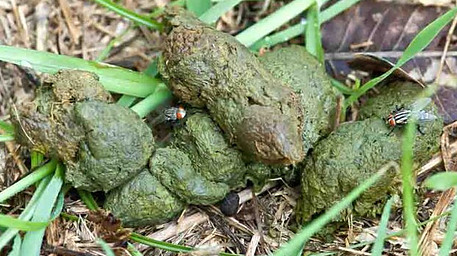
Green poop should be handled in a similar way to orange and yellow. It can indicate too much fat in the diet, parasites, or other digestive issues. However, if you see green poop and you suspect your dog may have gotten into rat poison, get to the vet as soon as possible. The sooner you get treatment, the better the outcome for your dog and the less it will cost you in time and money.
Normal Dog Poop Consistency
The consistency of your dog’s poop is another critical aspect to monitor. Normal stools are typically firm and well-formed. They should be easy to pick up and not super smelly.
Loose or watery stools can be a sign of dietary problems, infections, or gastrointestinal disorders.
Very hard and dry stools may indicate constipation, and your dog might be struggling with dehydration or a lack of dietary fiber.
The color and consistency may occasionally change for a bowel movement or two, but any consistent change should be checked out by a veterinarian. This is especially true if your pup is showing any other signs, such as vomiting, diarrhea, lethargy or not eating.
Conclusion
The bottom line (haha) is a dog’s poop provides valuable clues about their overall health. By noticing the color and consistency of your dog’s stool, you can detect potential problems early and ensure that your furry companion receives the necessary care. Remember that while minor variations can be normal, any significant or persistent changes should prompt a visit to the veterinarian. Keeping a close eye on your dog’s poop is a simple yet effective way to maintain their well-being and provide them with a happy and healthy life. You’re picking it up anyway…
Thanks for reading. If you have any comments, questions or suggestions, please leave them below, or email me directly a julie@carefordiabeticdog.com

